- Gorgeous design
- Comfortable and agile drive
- Surprisingly good value
- Styling calls for more power
- Rear headroom is tight
- Expensive servicing
We’re not going to talk about SUVs for a second. Save for one ute, our last 13 test cars have been SUVs and, quite frankly, it’s refreshing to be driving something different. Bizarrely enough, there was once a time where you wouldn’t describe a large sedan or liftback as a left-field choice as they used to be the family hauler of choice. Sedans were (and still are) spacious, easy to drive and comfortable but the biggest downfall of the humble sedan is that – other than high-end European models – they’ve never been seen as the most fashionable choice of transportation. The 2020 Peugeot 508 is here to change your mind.
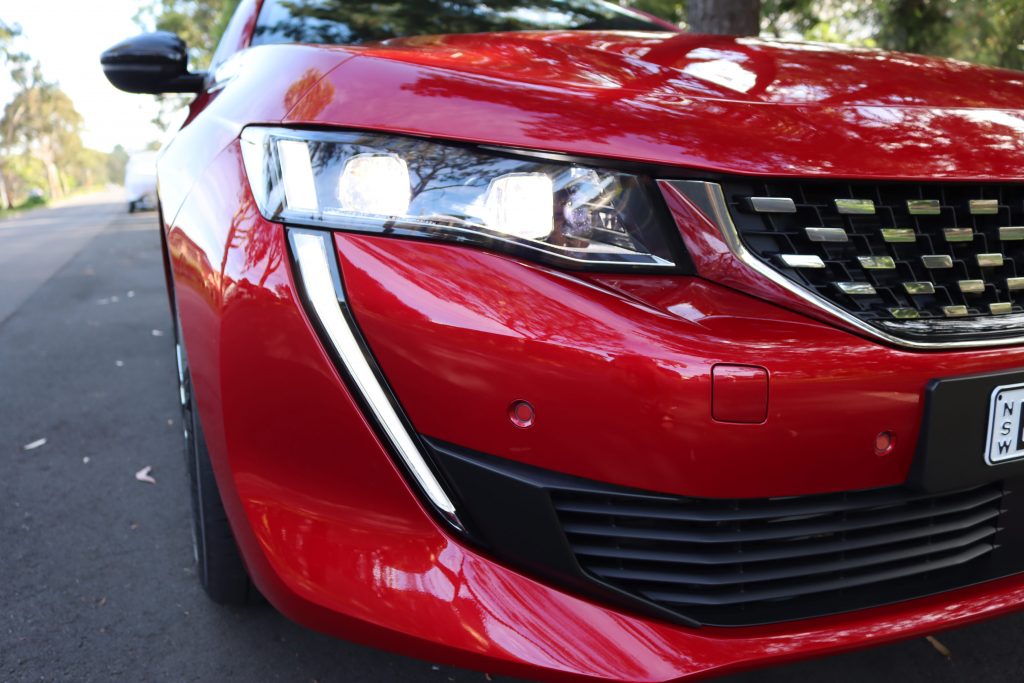
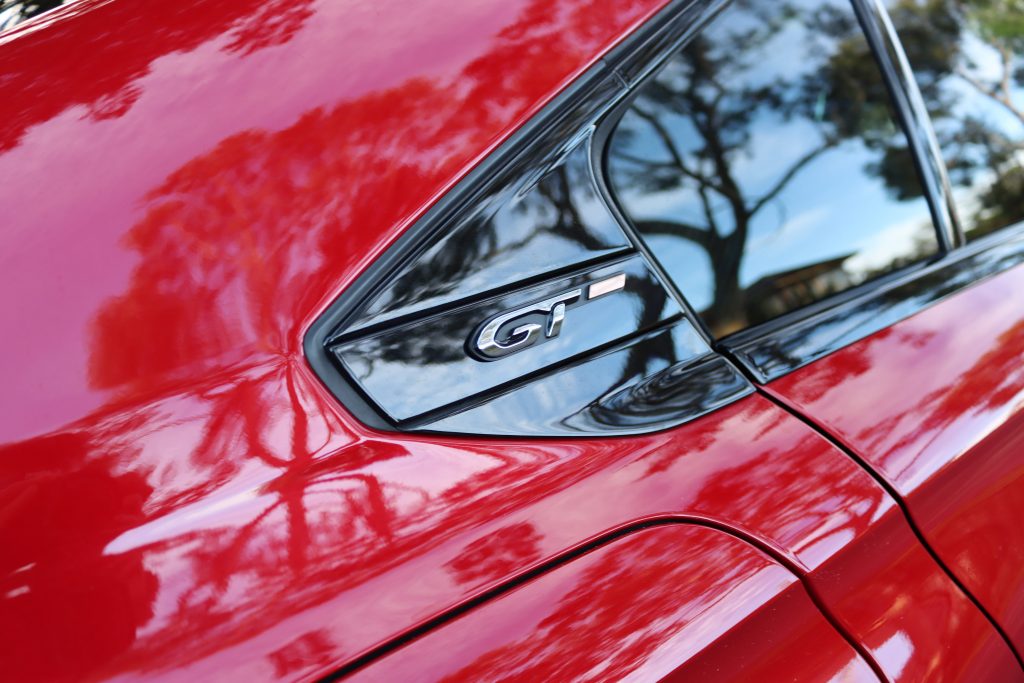
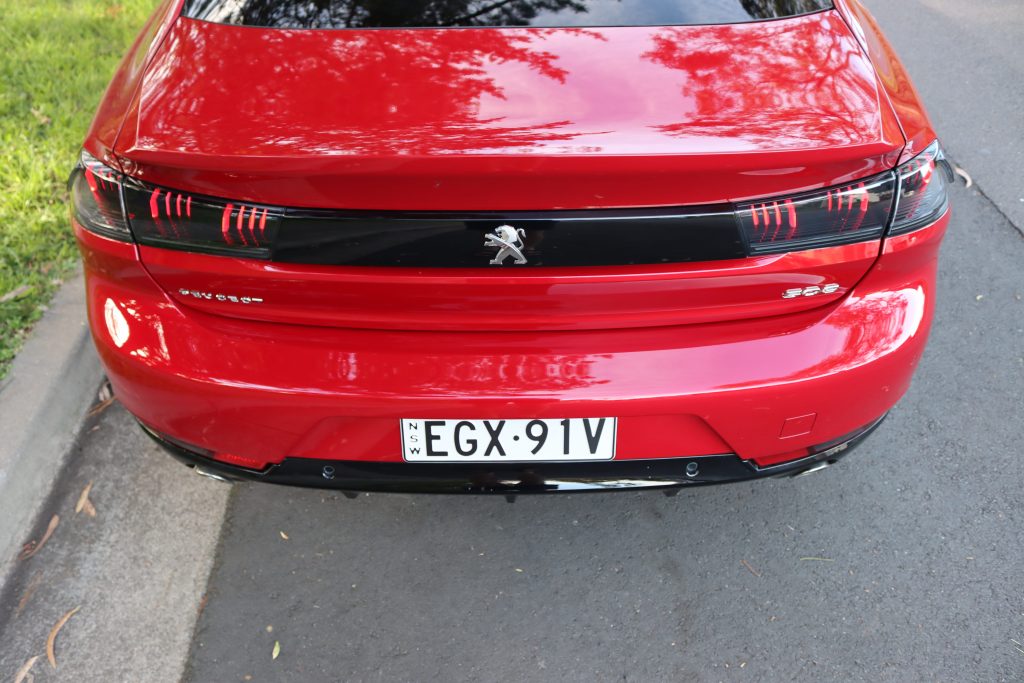
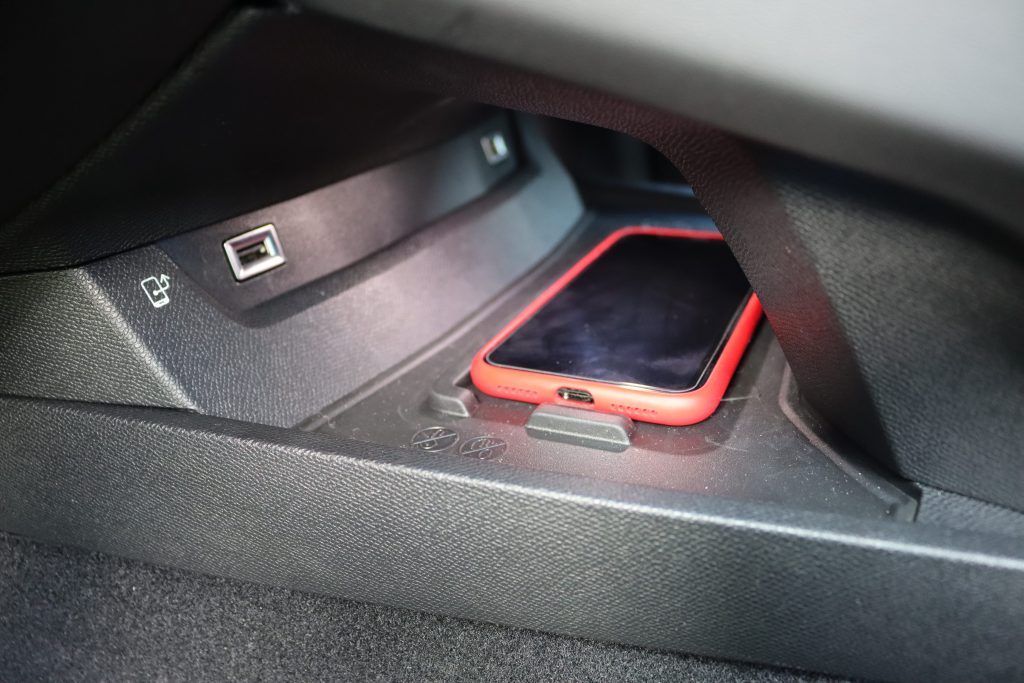
As families flocked to SUVs, Peugeot went a different route with the new 508 – trading in the conventional sedan getup for a slinky, coupé-inspired fastback design. The dramatic roofline, fang-like daytime running lights and sleek rear end all add up to a car that looks like a concept car that’s escaped Peugeot HQ and made its way onto the streets of Sydney. So, with the SUV being the pragmatic choice for a family car, how does the 2020 Peugeot 508 go at appealing to your head and your heart?
Price & Specs: 8.0/10
Peugeot Australia offers the 508 in one fully-loaded spec: the GT. You can have the 508 GT Fastback for $56,990 drive away, while the 508 GT Sportswagon will set you back a further $2000 – totaling at $58,990 drive away.
Standard equipment includes the usual array of safety systems including autonomous emergency braking (AEB), adaptive cruise control that combines with the lane-keep assist to offer a with semi-autonomous highway driving assist, blind-spot monitoring and six airbags.
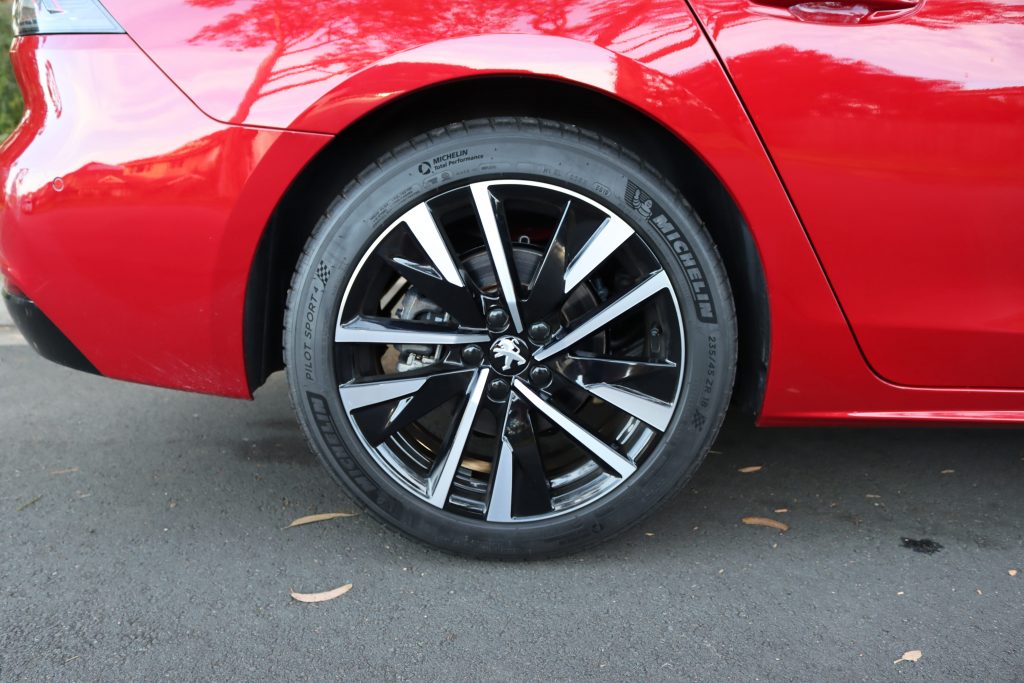
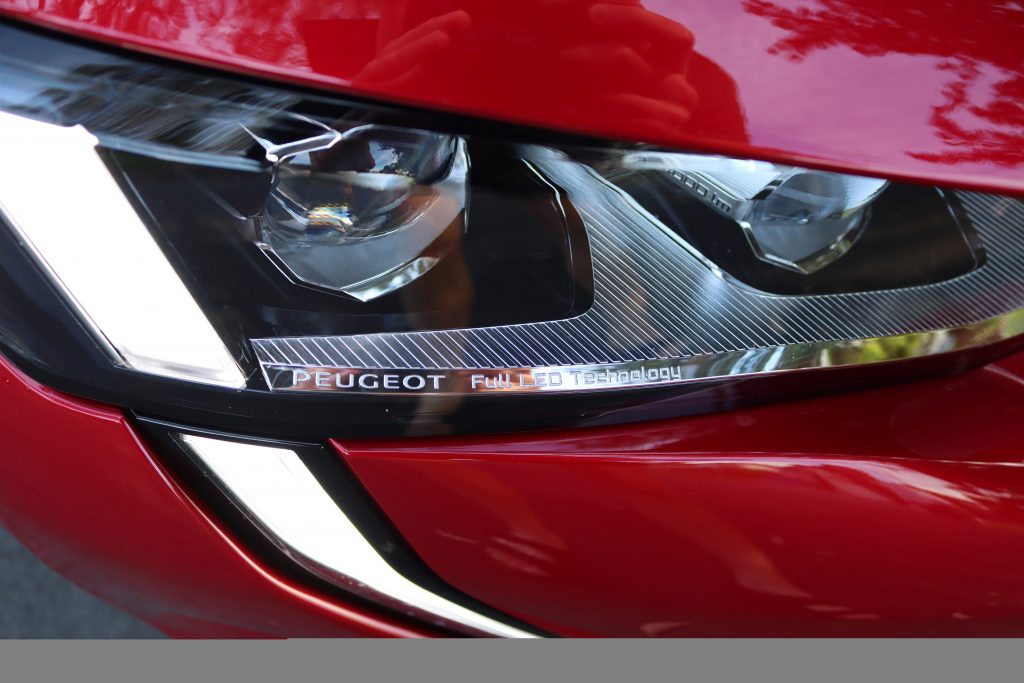
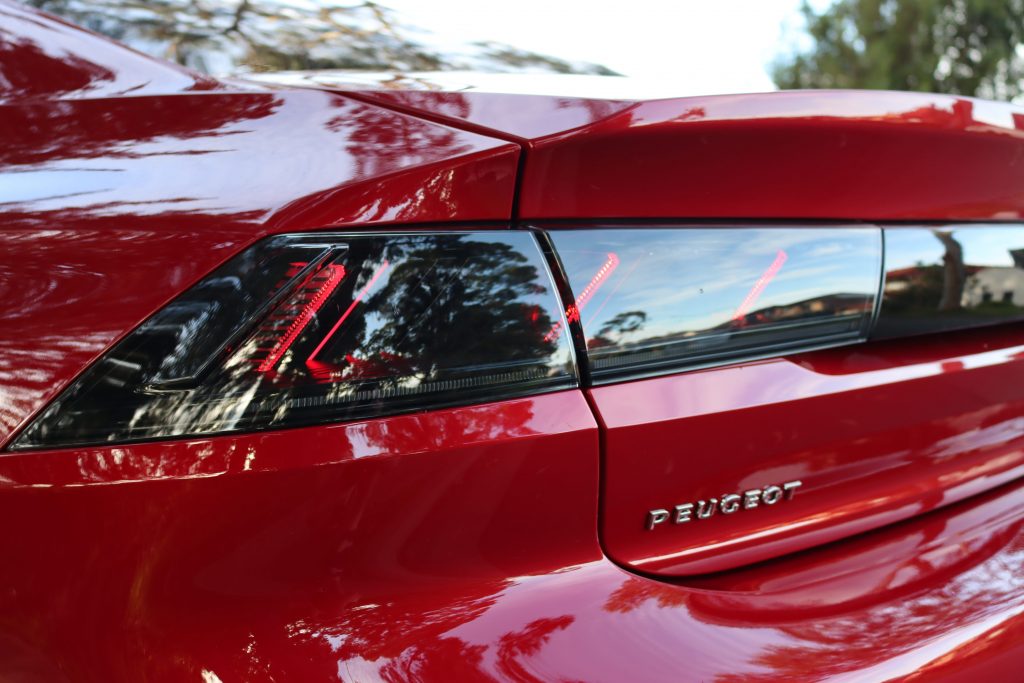
It also gets 18-inch alloy wheels, auto-folding mirrors, adaptive dampers, full-LED lighting with auto high beam, auto-dimming exterior and interior mirrors, a proximity key with push-button start, an electric hands-free tailgate, an electronic handbrake, engine stop/start, Nappa leather upholstery with massaging front seats, ambient lighting, a wireless phone charger, a 12.3-inch digital driver’s display, a 10.0-inch infotainment touchscreen with built-in navigation, Apple CarPlay and Android Auto, and a 10-speaker Focal premium sound system.
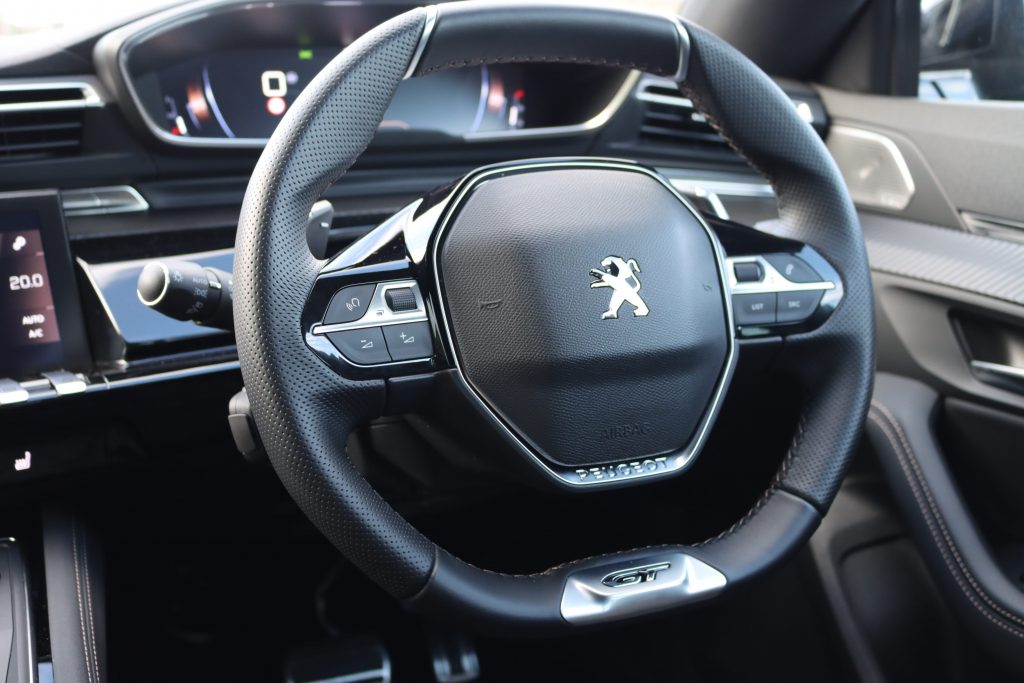
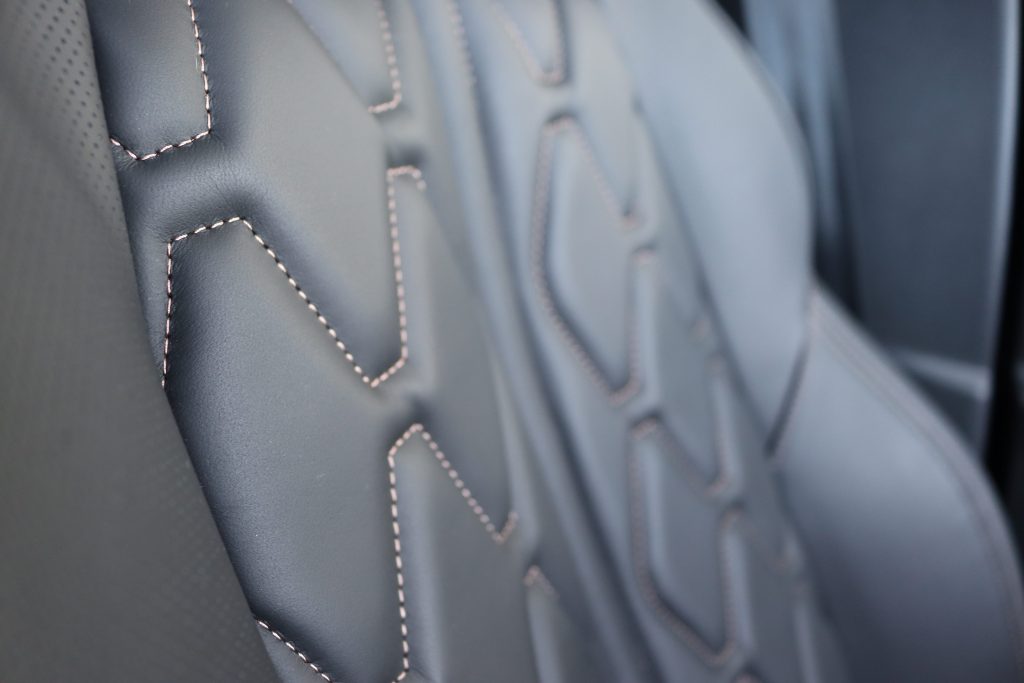
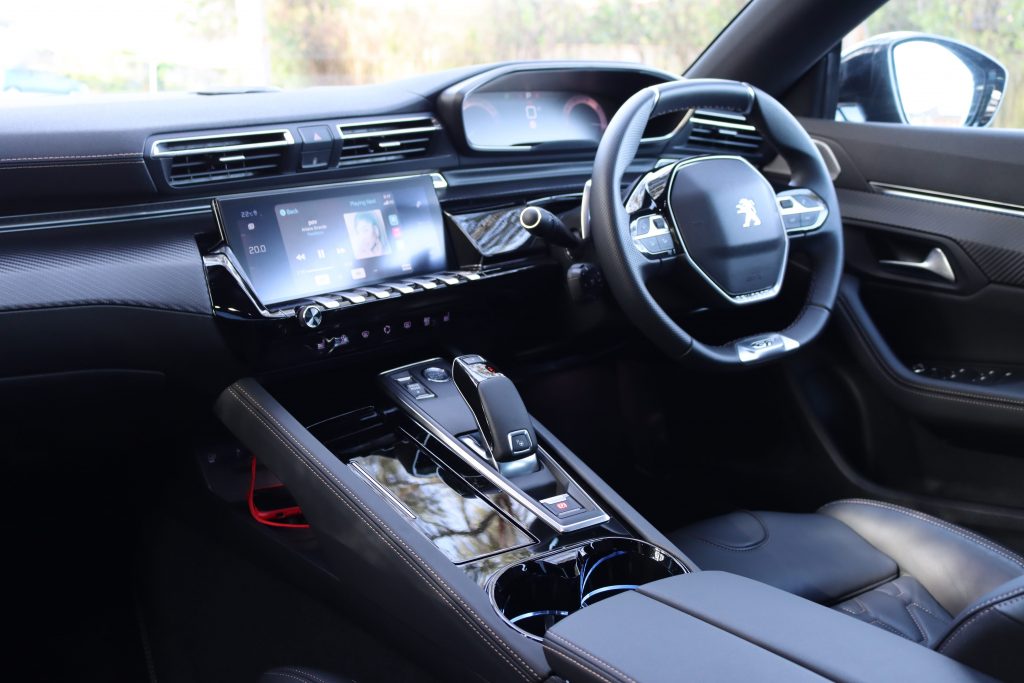
The 1.6-litre turbocharged four-cylinder petrol is the only engine option in Australia (for now) and the only optional extra is an electric panoramic sunroof for $2,500. Metallic paints are an additional $690 and premium paints, including the ‘Ultimate Red’ that adorned our test car, will set you back $1,050.
Our 508 GT Fastback was finished in Ultimate Red and opined with the sunroof, coming to a total of $60,540 drive away. A Skoda Superb is arguably the closest rival to the Peugeot 508 as it’s a large sedan-like liftback from a left-field Euro brand. While the now-defunct 162TSI was more in line with the 508’s 165kW 1.6-litre turbo engine, the only Superb liftback currently on sale in Australia is the full-fat Sportline packing 206kW and all-wheel drive for $62,990 drive away. Adding premium paint, a panoramic sunroof and leather seats with massage function (driver only) to match the 508’s standard kit brings the Superb’s price up $67,690 but it more than makes up for it in the performance department.
Performance & Economy: 8.0/10
Seeing as Peugeot Australia opted for the GT only, we’re treated with Peugeot’s familiar 1.6-litre turbocharged petrol engine making 165kW at 5500rpm and 300Nm at 2750rpm. Drive is sent to the front wheels via an Aisin eight-speed automatic transmission of the traditional variety. This helps the GT Fastback hit 100km/h in a respectable 8.1 seconds.
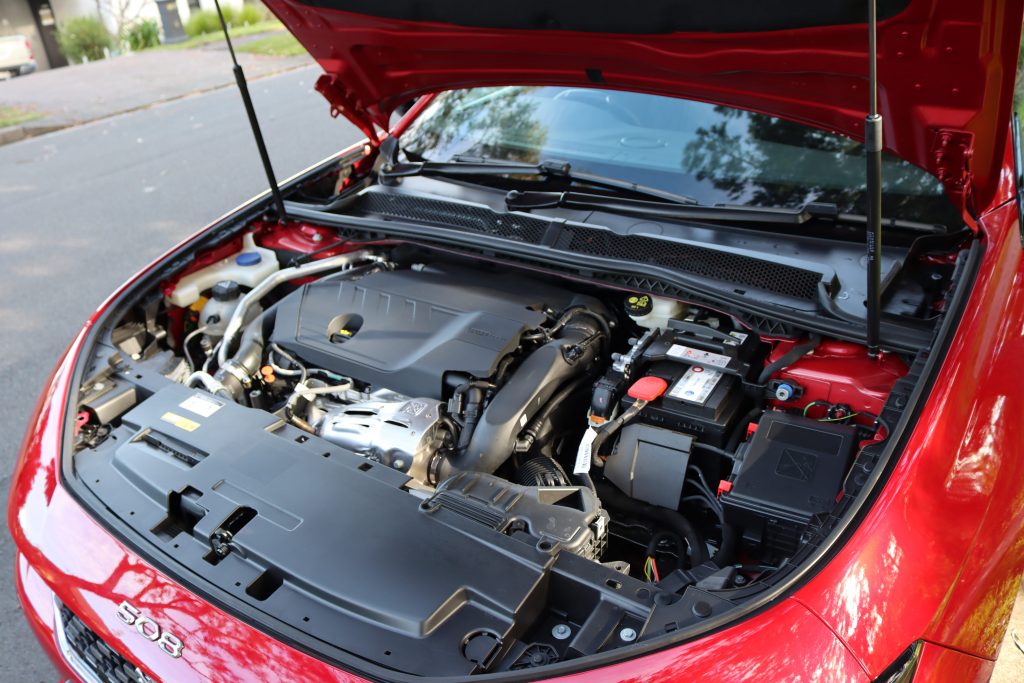
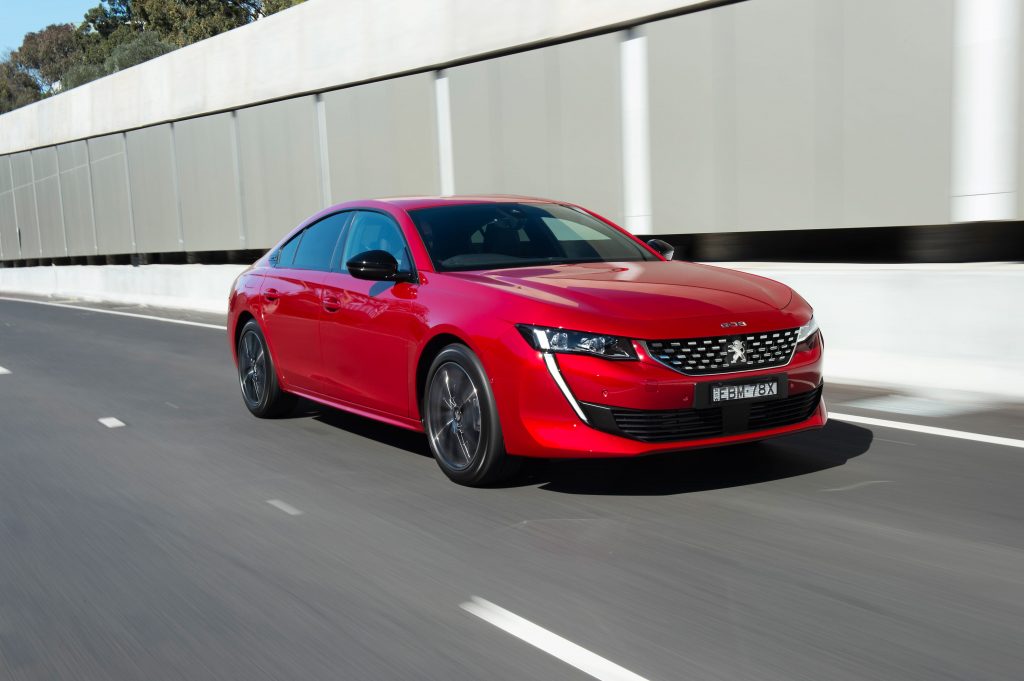
First impressions of the drivetrain is that the 508 is a smooth operator courtesy of that slick eight-speed auto. No awkward DSG fumbles here, the Aisin torque converter earns its keep around town as well as on the open road – subtly swapping cogs at lower speeds and decisively picking the right ratio on the motorway.
It’s also paired well with the small-for-the-class 1.6-litre engine. The combination of the 508’s tiny kerb weight – a lithe 1,385kg for the Fastback – with the low-down torque from the turbocharger resulting in a surprisingly spritely drive. Small throttle inputs are met with the enthusiasm you’d expect from a warm hatch and it encourages you to have a bit of fun behind the wheel. This sensation is felt during most of your everyday driving such as taking off from traffic lights and navigating carparks.
“The combination of the 508’s tiny kerb weight – a lithe 1,385kg for the Fastback – with the low-down torque from the turbocharger resulting in a surprisingly spritely drive.”
Ask for a bit more by pushing the throttle beyond three quarters and the engine starts to run out of steam. The 1.6 feels diesel-like in the way its response is more satisfying lower down the rev range rather than screaming at its upper limits. It’s not slow by any means, but the slinky body promises more in the performance department than the 1.6 can deliver. We’ll just have to wait for the 272kW 508 Sport Engineered. The drive modes go some way to compensating for the lack of outright grunt, with sport mode sharpening throttle response and manual mode letting the driver decide on ratios by themselves.
“The 1.6 feels diesel-like in the way its response is more satisfying lower down the rev range rather than screaming at its upper limits.”
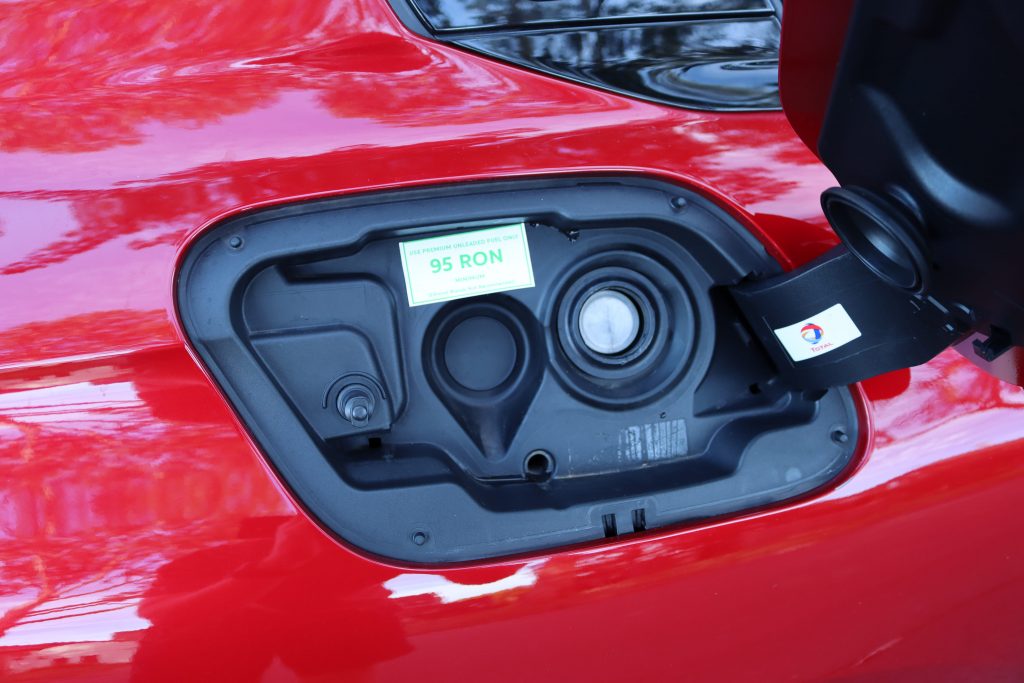
Curiously, the stop/start system didn’t engage in our time with the 508, even in eco mode. Stopping the car often saw the stop/start symbol flash three times but it didn’t ever go as far as killing the engine. At least consumption was still good for the class, with our car averaging 8.3L/100km in the time we had it. While a fair bit off the (impressive) claimed figure of 6.3L/100km, we spent most of our time in urban driving and without the help of stop/start. It’s also worth noting that the 508 expects 95RON minimum but we’d recommend filling up with 98RON as the it’s one of the very few cars currently on sale in Australia with a petrol particulate filter and higher-RON fuel has less PPF-killing sulphur.
Those hunting for more serious performance are better off looking at the Skoda Superb 206TSI Sportline, which catapults to 100km/h in just 5.8 seconds. It is worth noting that you will pay for the extra go thanks to the higher entry price and fuel economy that will easily sit above 10.0L/100km.
Ride & Handling: 9.0/10
The French are known for their cosseting suspension setups and the 2020 Peugeot 508 is no different. The 508 rides on adaptive dampers with five unique modes and sensible 18-inch alloy wheels with quality Michelin rubber. The dampers are well sorted regardless of which setting you choose and help to allow the 508 transform from a typically luxurious ride to a surprisingly sporty fastback.
The 508 deals with the usual lumps and bumps Sydney’s roads have to offer with aplomb without ever feeling like it wallows about or lacks composure. It feels like a true grand tourer in the way it effortlessly eats up kilometres in quiet comfort. Paired with highway assist, which utilises adaptive cruise control and active lane-keep assist to provide motorway-friendly autonomy, and it makes for a perfect companion to cover kilometres in.
“It feels like a true grand tourer in the way it effortlessly eats up kilometres in quiet comfort.”
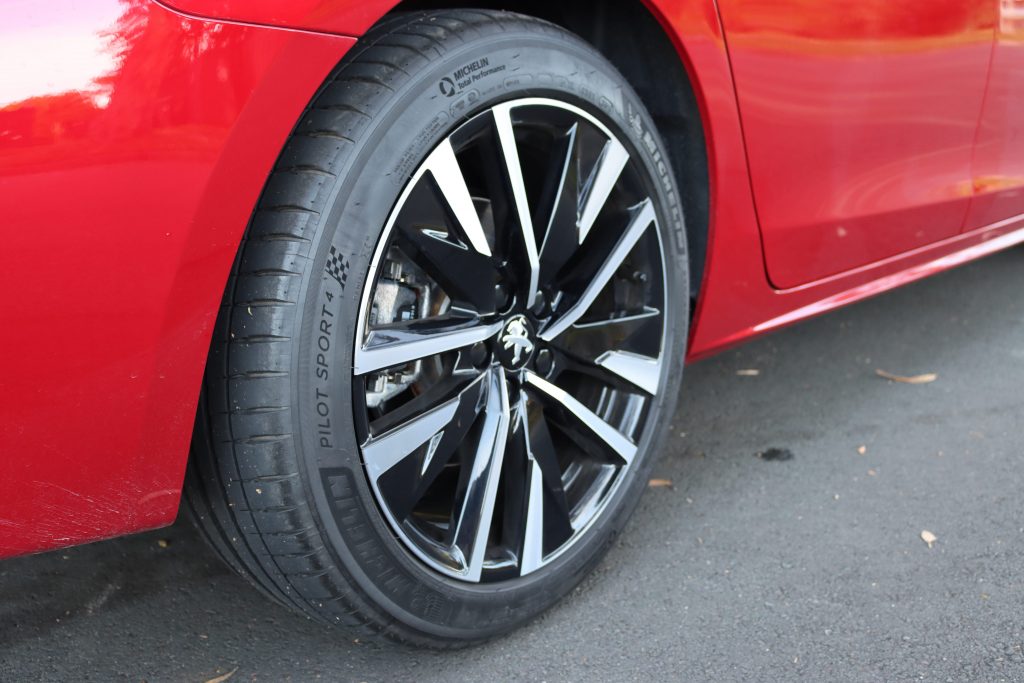
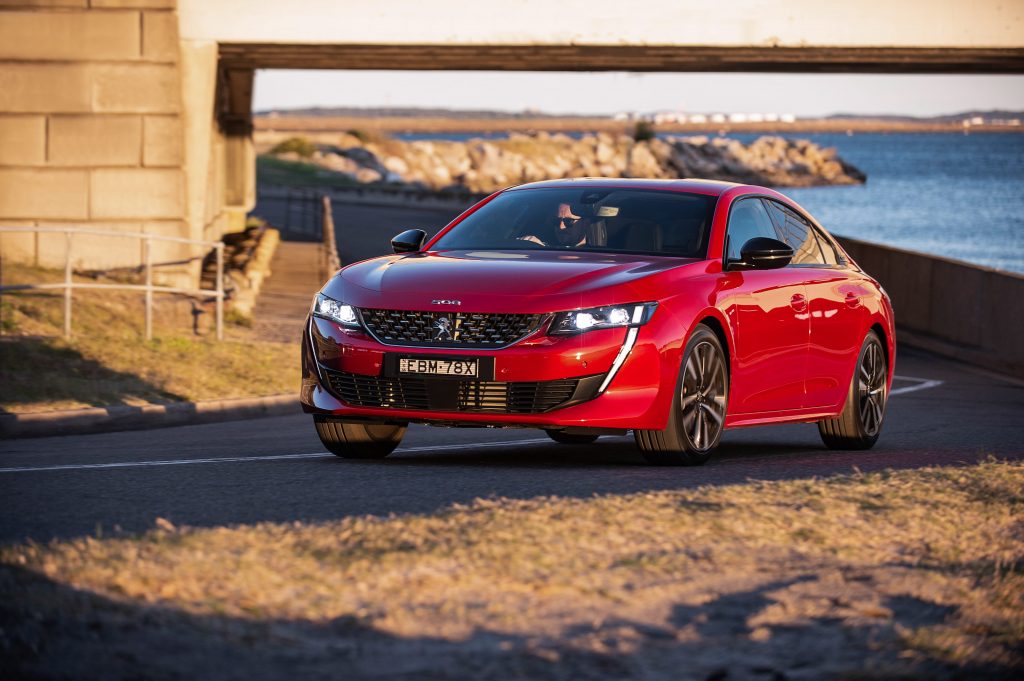
The tiny steering wheel sits low down, almost in your lap, and takes a second to adjust to as it reacts quickly to even the smallest movements. The short steering ratio feels disconcerting at first, but a few minutes behind the wheel and you quickly acclimatise to it. While not the last word for steering ‘feel’, it helps the 508 feel endlessly agile despite its size and it changes direction with ease. Again, it feels far sportier than a large comfy cruiser has any right to. The 235/45R18 Michelin Pilot Sport 4 tyres provide loads of grip, allowing the 508 to hold on and resist understeer better than a large front-wheel drive car should – no doubt helped but its light kerb weight.
“The 235/45R18 Michelin Pilot Sport 4 tyres provide loads of grip, allowing the 508 to hold on and resist understeer better than a large front-wheel drive car should…”
Combine the baby steering wheel with a tight turning circle and ergonomic gear selector and you get a big car that makes light work of carparks and three-point turns in tight city streets. The makeshift 360º camera – which uses the front and rear camera to fill in the area missing as you drive – is also better than a simple reverse camera, if worse than a proper 360º setup. The only gripes with manoeuvring the svelte fastback are the rear blindspots and letterbox-thin rear windscreen.
The Skoda Superb might be able to match the 508 in terms of ride comfort, but it can’t match the 508’s sheer agility thanks to an extra 188kg of heft it needs to lug around when changing direction.
Interior & Practicality: 9.0/10
To sum it up in one word, the interior of the 2020 Peugeot 508 is gorgeous. This is where you’ll be spending most of your time and you better believe that Peugeot made sure you’re going to enjoy it. Open the driver’s door to be greeted by frameless windows – just like a real coupé – and lower yourself into the Nappa leather pews. Closing the door is accompanied by a solid thunk and the i-Cockpit driver’s display lighting up and animating its startup.
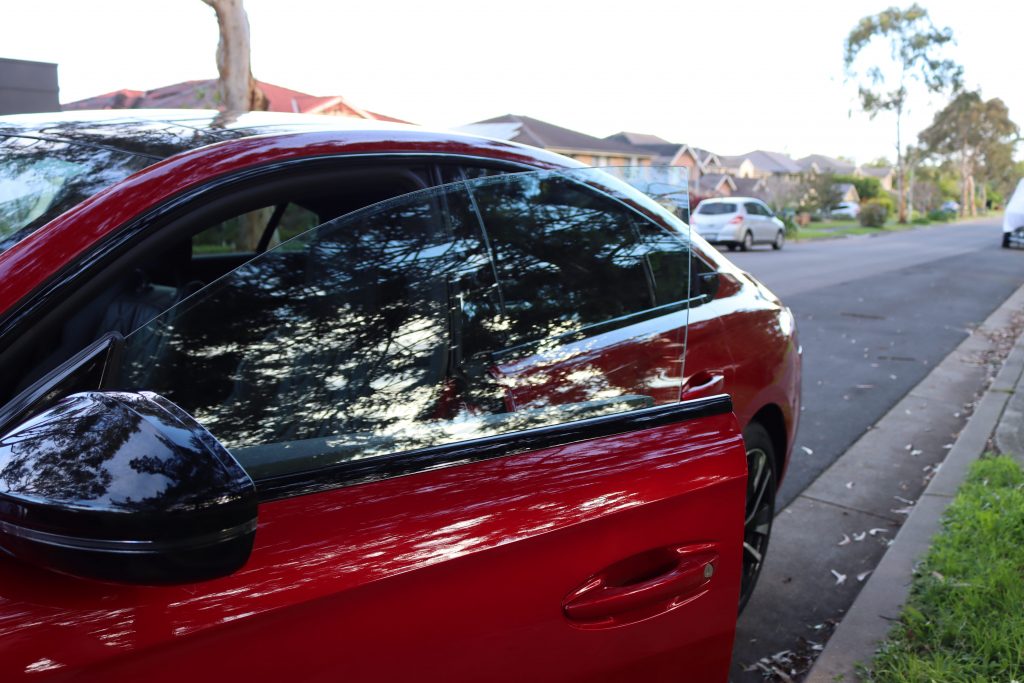
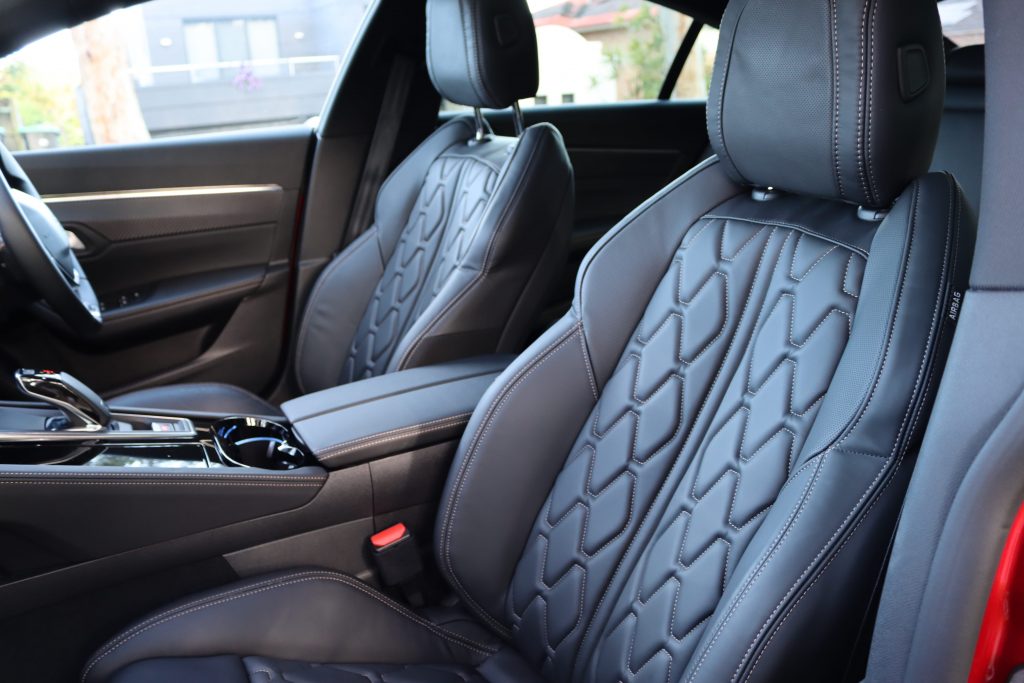

Material choices are tasteful and cohesive, with black leather and a soft-touch carbon-effect material covering most surfaces. Copper highlights can be seen in the stitching of the seats, dash, centre console and is also mirrored in the user interface of the infotainment system and digital driver’s display. The attention to detail is evident and it creates the impression of a cabin that is much more expensive than it really is. The only noticeable flaw is the gloss black cover for the centre console’s storage compartment, which creaks when you press to open or close it and detracts from an otherwise well-finished interior.
“The attention to detail is evident and it creates the impression of a cabin that is much more expensive than it really is.”
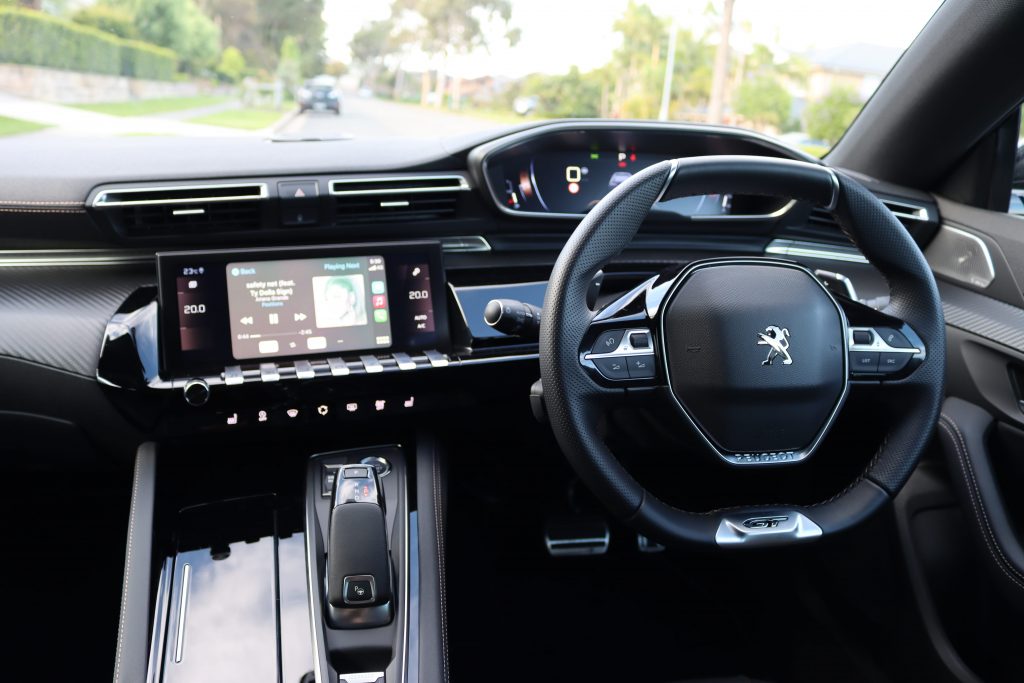
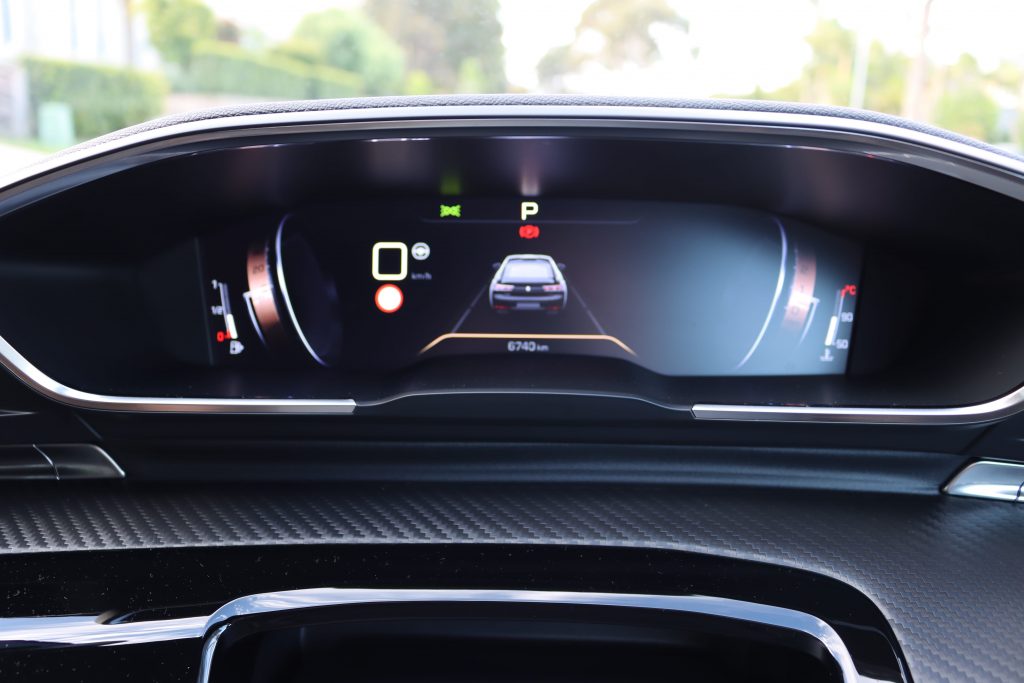
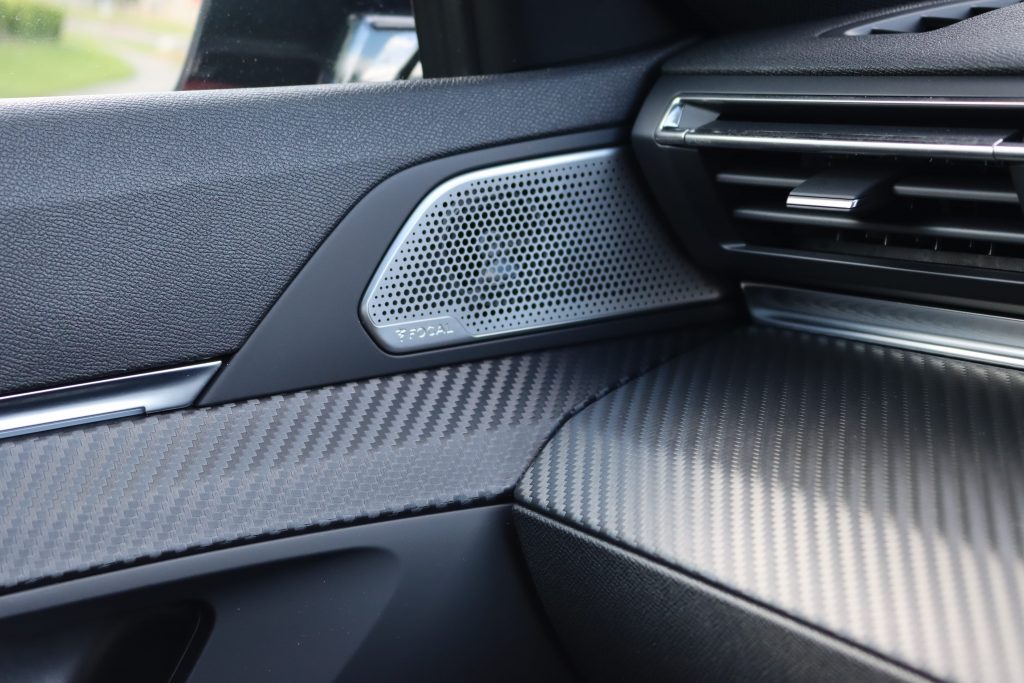
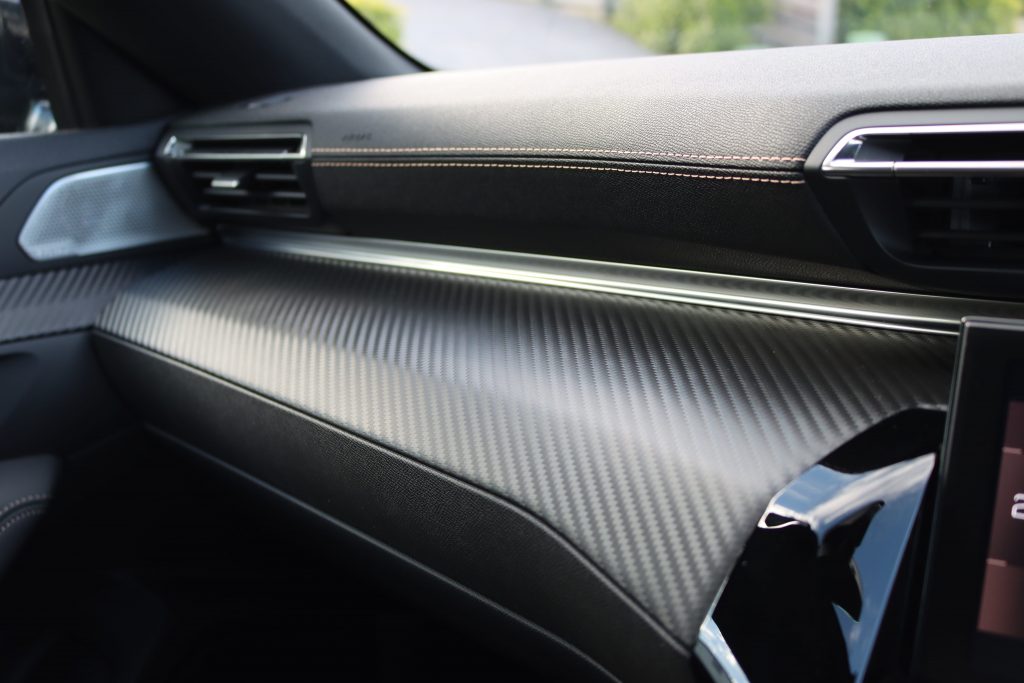
The tiered design of the dash sees the top level house air vents and the configurable 12.3-inch digital driver’s display – which gives you the choice of old-school dials, navigation, minimal and more. The next level down houses the 10.0-inch touchscreen with piano-style hot keys and the bottom level housing touch-sensitive buttons for other controls such as heated seats, climate functions and stop/start. Many will cry foul about the climate controls being condensed into the touchscreen but the wider-than-average screen means that the two climate zones are almost always visible and readily accessible. The hot keys also makes easy work of jumping from function to function and the reasonably quick CPU means you’re rarely left waiting for the screen to respond. The proprietary satellite navigation is easy enough to use but many will prefer the convenience of Apple CarPlay or Android Auto, with the only downside of phone mirroring being that you can’t put full-size mapping on the digital driver’s display. The cranking 10-speaker Focal premium sound system also sounds as good as the aluminium branded tweeters look and the massaging driver and passenger seat are something you would expect from a much more expensive car.
“Many will cry foul about the climate controls being condensed into the touchscreen but the wider-than-average screen means that the two climate zones are almost always visible and readily accessible.”
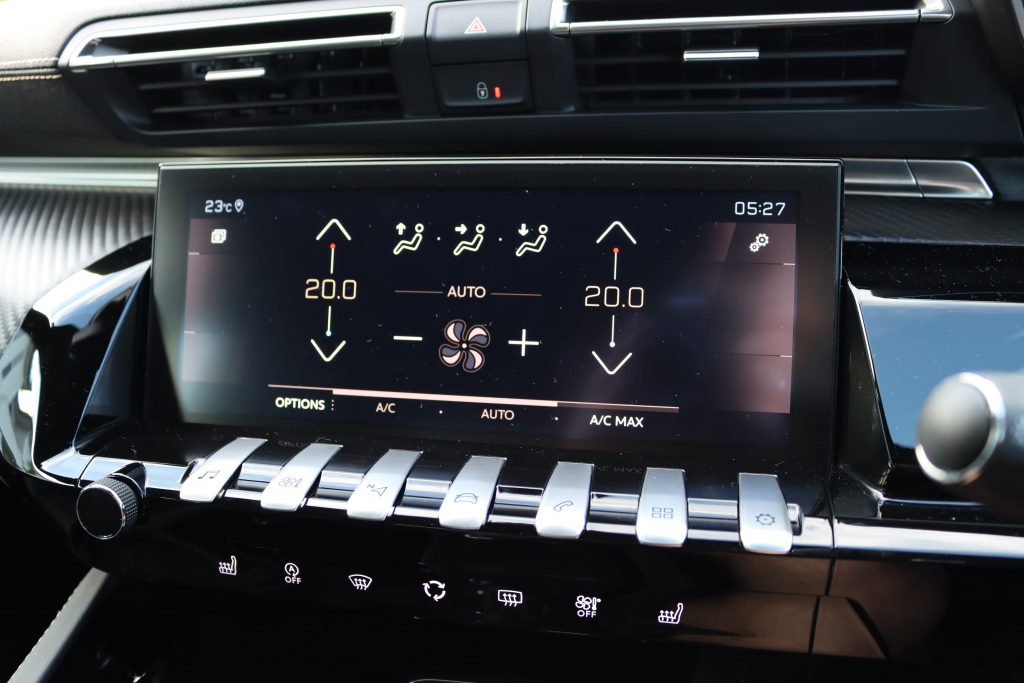
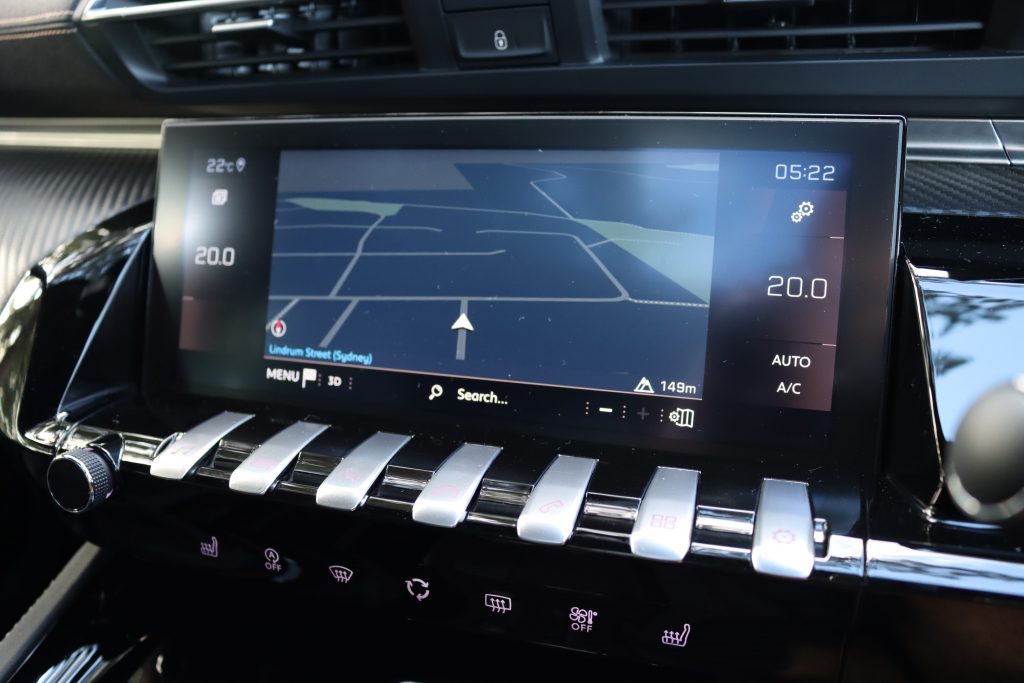
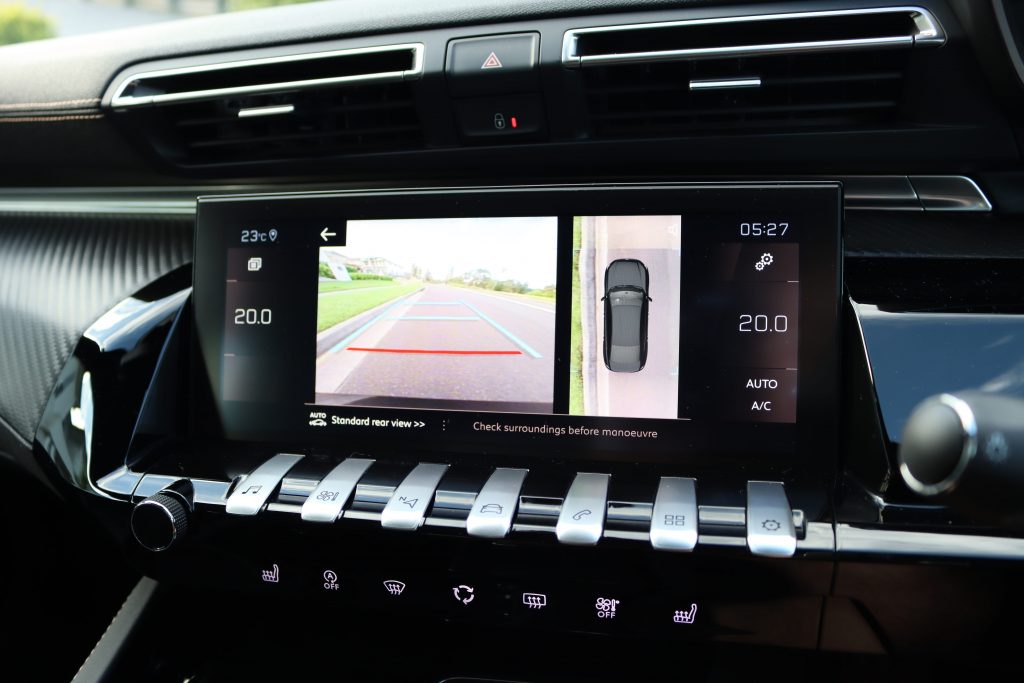
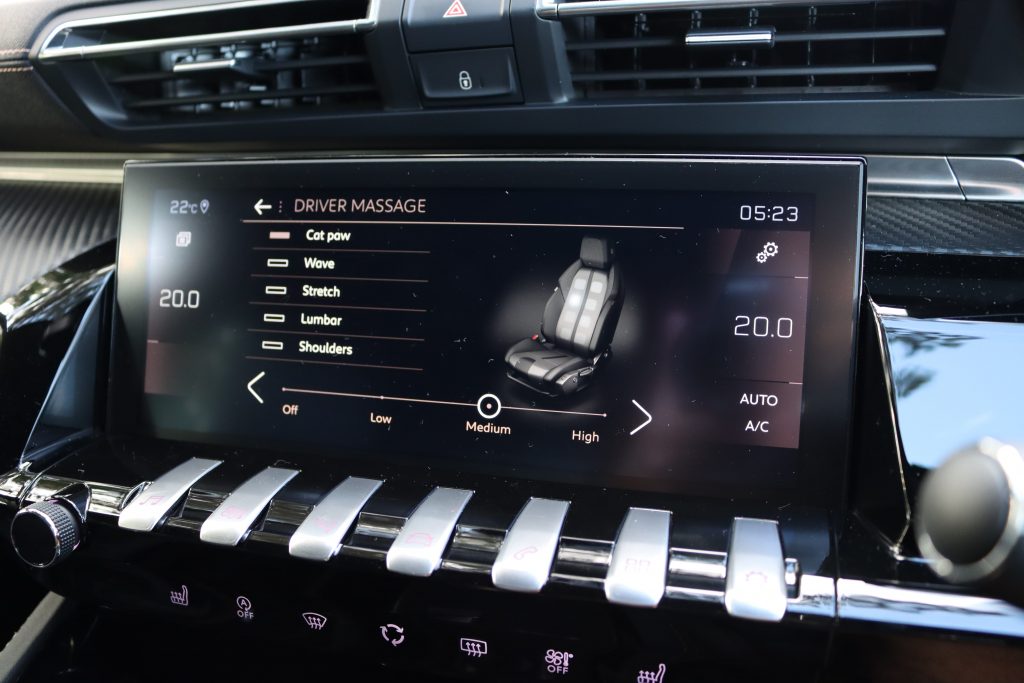
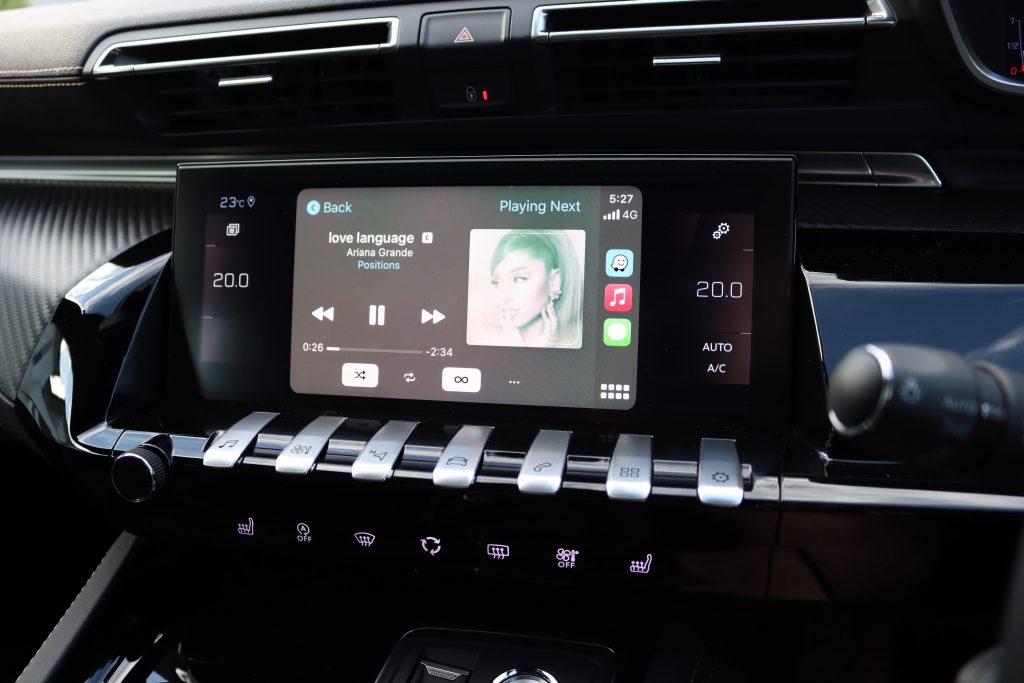
The centre console features the stylish electronic gear selector and an array of storage – including two generous cupholders, a twin-door centre armrest hiding a large storage area with a USB port, and a secret lower shelf with wireless smartphone charging, a USB port (this one for smartphone mirroring) and a 3.5mm auxiliary jack. In terms of other storage, the door bins that can comfortably hold all but the largest bottles and the glovebox is typically French (read: useless).
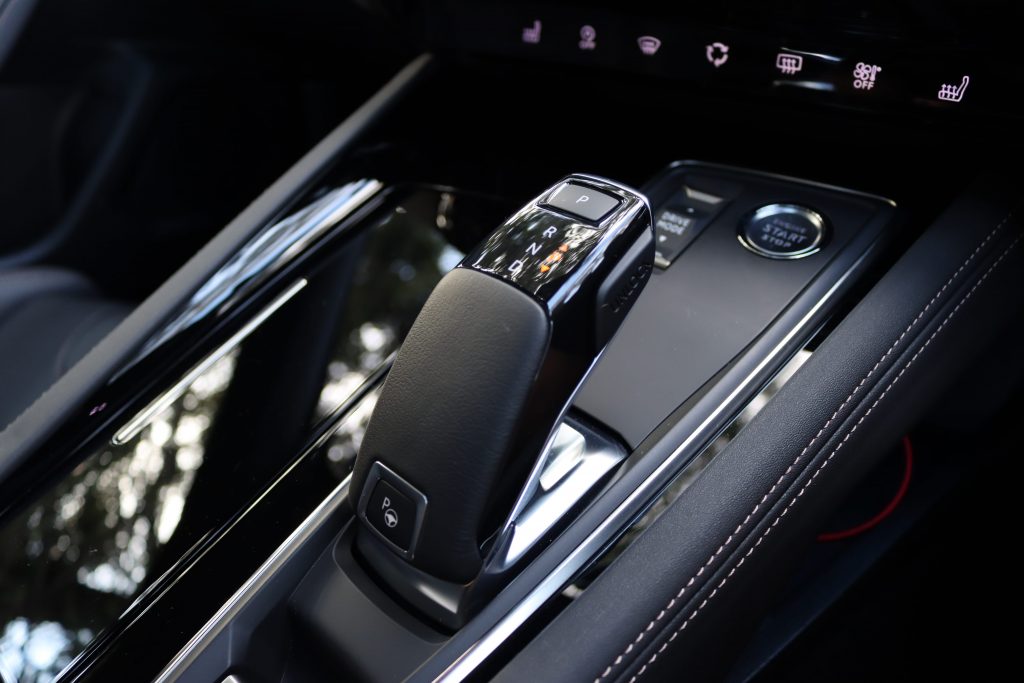
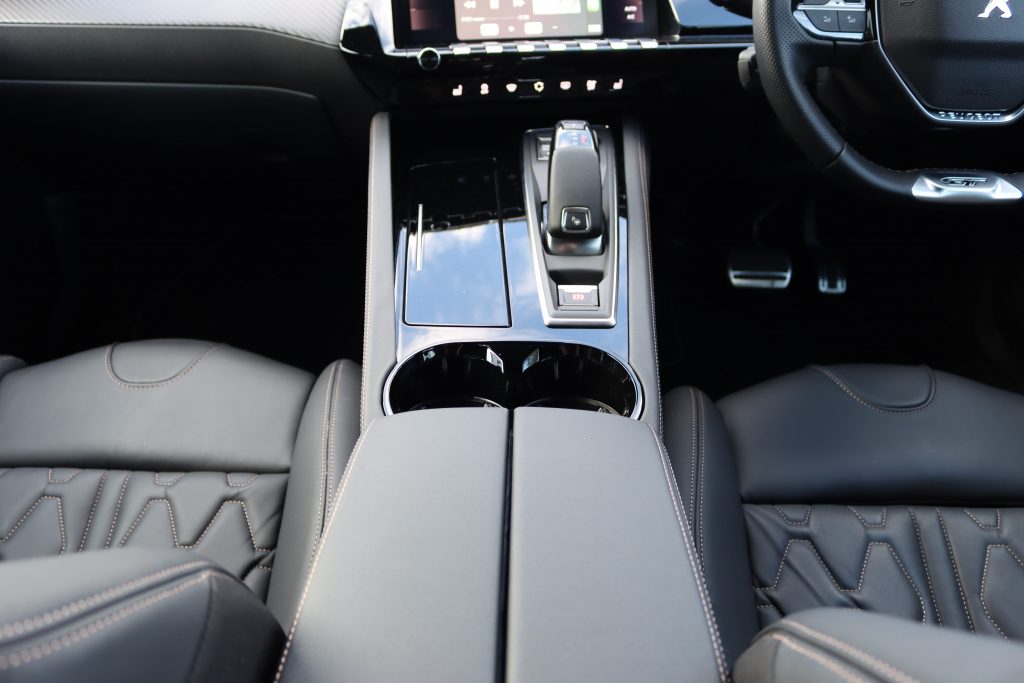
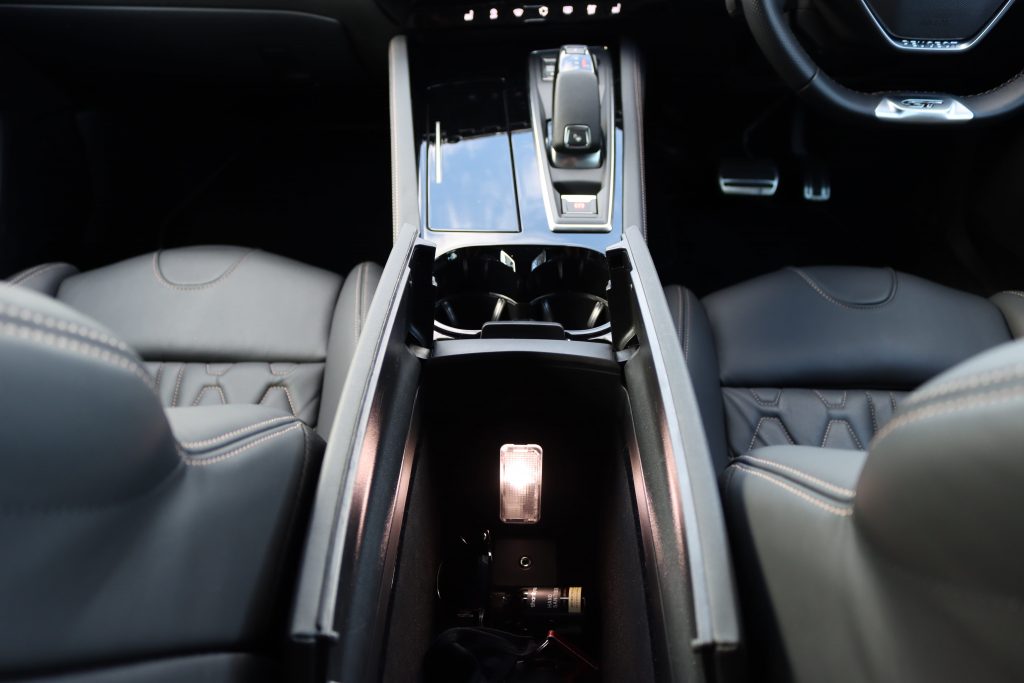

The rear is treated with the same quilted Nappa leather, soft-touch materials on the doors, a centre fold-out armrest with cupholders, air vents and even two USB ports. There’s a good amount of leg and shoulder room in the back but the sloping roofline means those who plan to regularly cart around tall friends or parents with lanky teenagers might want to consider the Sportswagon as it offers more headroom.
“…the sloping roofline means those who plan to regularly cart around tall friends or parents with lanky teenagers might want to consider the Sportswagon as it offers more headroom.”
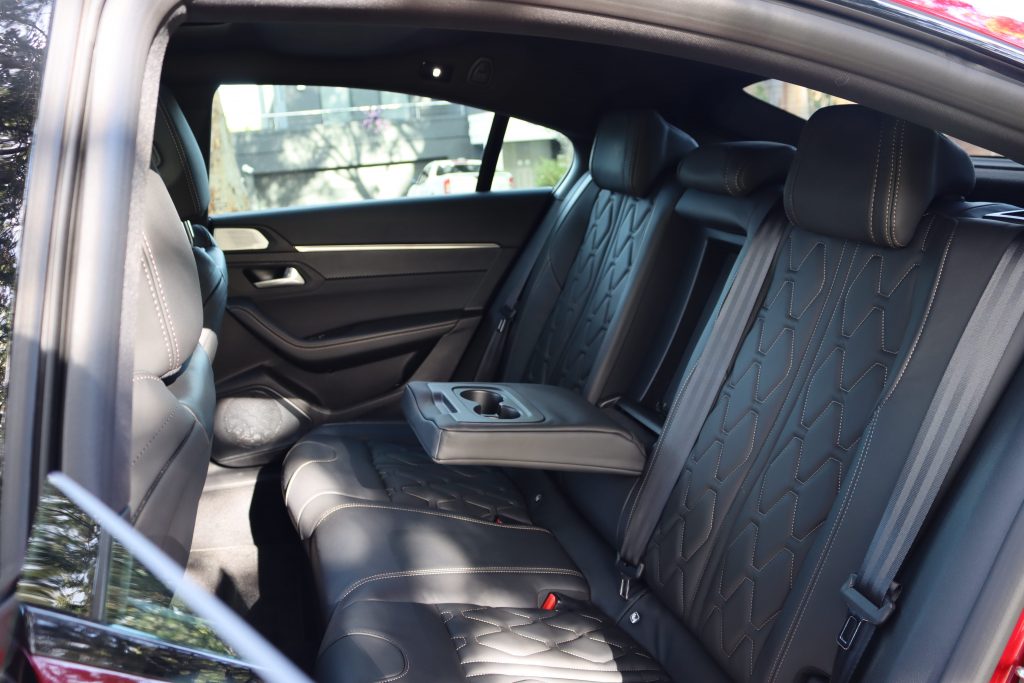
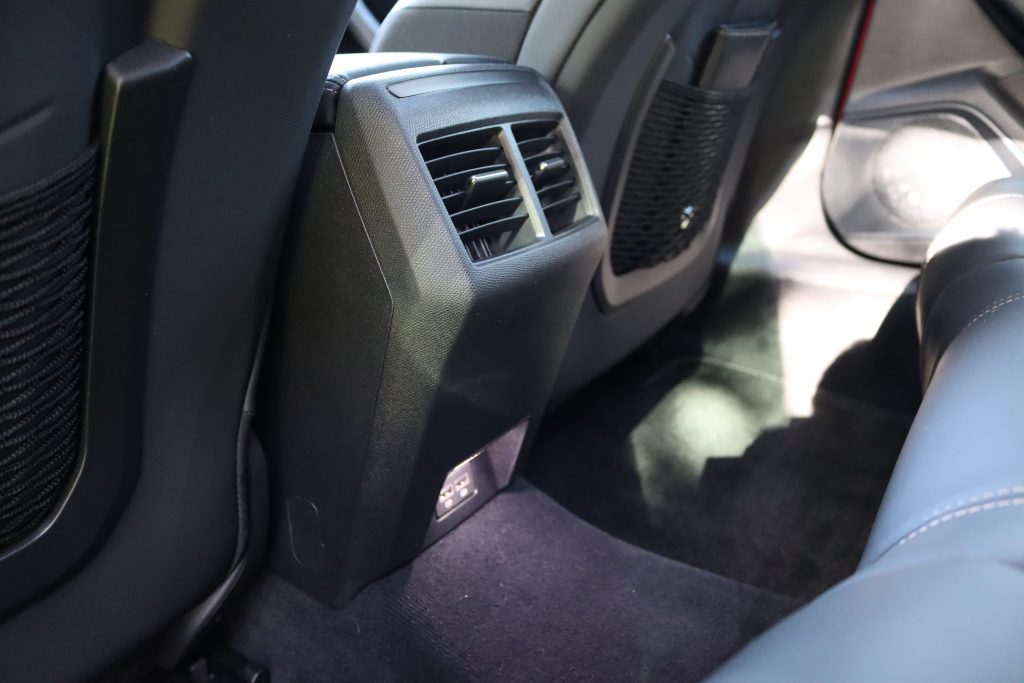
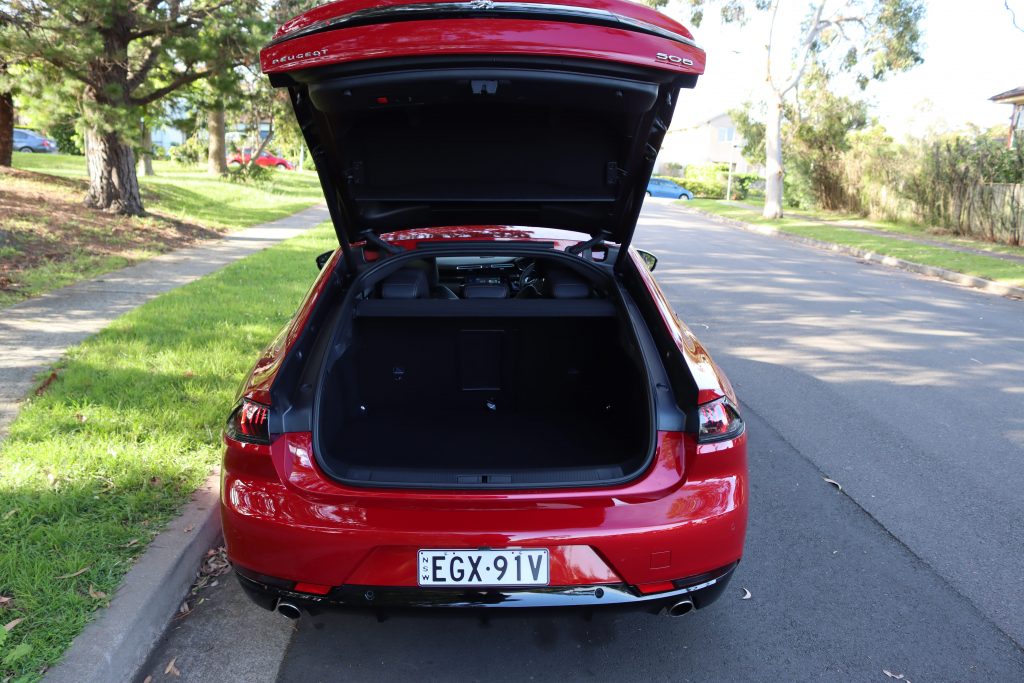
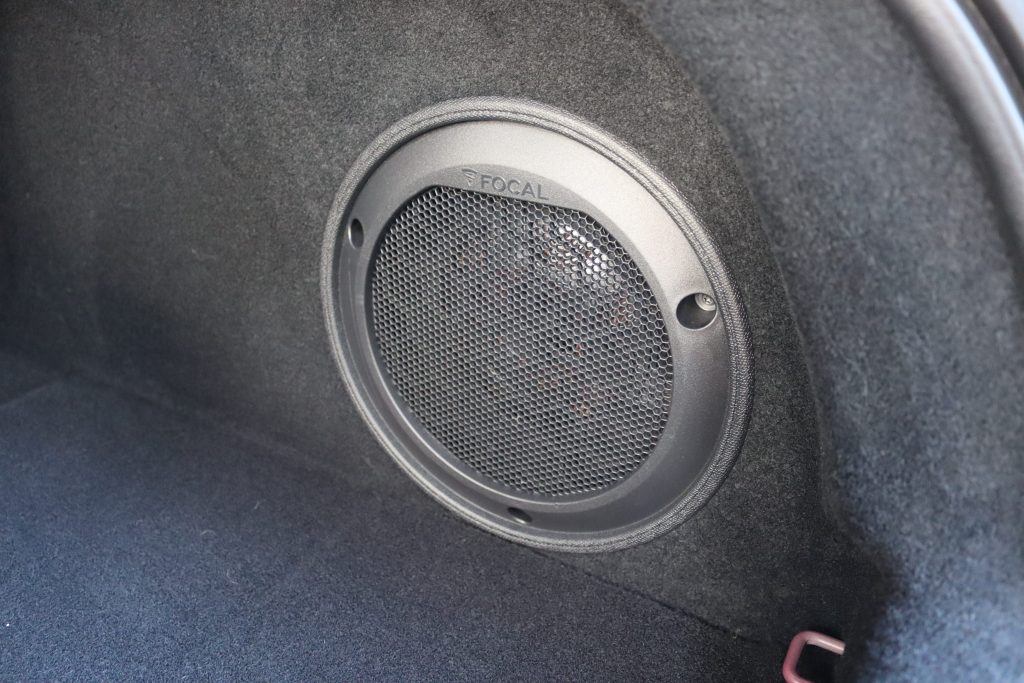
The 508’s fastback body style offers a huge electric tail gate which makes it a breeze to load items into the 487-litre boot. Fold the rear seats down and it opens up to an even more expansive 1,537-litre space with a flat floor. Packing the Focal subwoofer into the side rather than underneath the boot floor free up space for a spare wheel, albeit a space saver.
The Skoda Superb muscles in on the Peugeot 508 with its Tardis-like interior – offering limo-like rear passenger space and a huge 625-litre boot that expands to 1,760 litres with the seats folded flat. The clincher for the 508 is that its interior feels more premium and more inviting than the decidedly somber and restrained Superb’s interior.
Running Costs & Warranty: 6.5/10
Peugeot’s five-year/unlimited kilometre warranty might be the new norm for most manufacturers, but it’s also matched with an impressive five years of roadside assistance. European rivals such as the Skoda Superb only offer a single year of roadside support, though that is topped up by a year with each scheduled service. That said, servicing the 2020 Peugeot 508 is hardly what you’d call cheap.
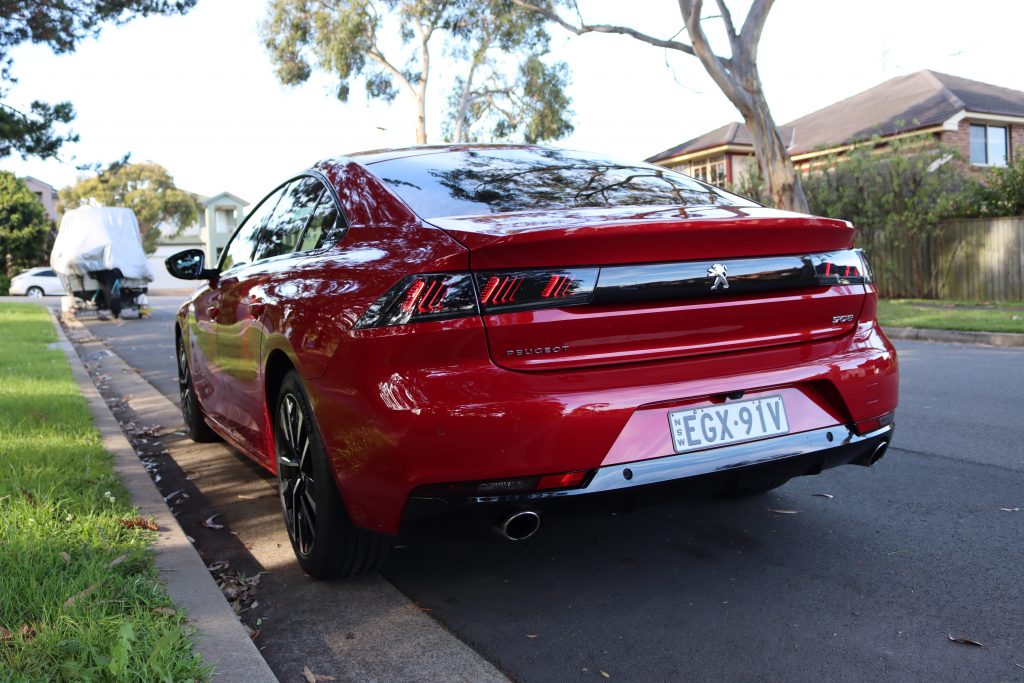
Peugeot’s capped-price servicing might help negate and surprises for the first five years but it’s expensive – the first five years costing an eye-watering $3,507. By comparison, Skoda will sell you a five-year service pack for your Superb costing just $1,700. Those who cover a lot of kilometres will appreciate the 508’s slightly longer 20,000km service intervals versus the Skoda’s 15,000km, but it’s not enough to justify costing twice as much.
2020 Peugeot 508 GT DiscoverAuto Rating: 8.1/10
Australians might be rushing to trendy SUVs in droves but the truth is there are still a handful of excellent large family sedans and wagons that can tick as many, if not more, boxes and appeal to your heart at the same time. The 2020 Peugeot 508 GT Fastback is a prime example. In our time with it, we had plenty of curious passers-by stop us to ask about the car or simply gawk over it as we drove past. It offers a lot of technology, an excellent drive and an efficient drivetrain wrapped in a drop-dead gorgeous package that no SUV at this price point can offer.
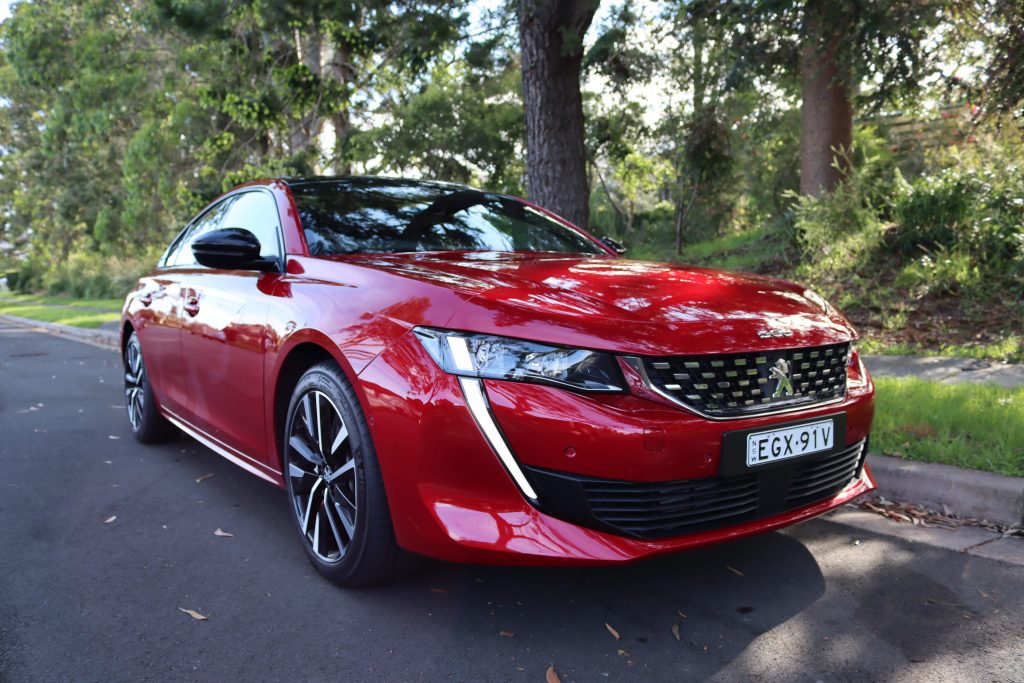
Drawbacks? The lack of rear headroom makes it less ideal if you plan to regularly ferry around tall passengers but it is easily remedied by opting for the equally gorgeous estate. The expensive servicing is more difficult to overlook, and is arguably the biggest hurdle the French manufacturer has to face if it intends to take on more mainstream rivals. Regardless, the 2020 Peugeot 508 is an excellent car that provokes you to think outside the SUV-shaped box rather than following the Jones’ and it deserves to be on your shopping list.
More: Latest on the Peugeot 508
More: Latest Peugeot News and Reviews
Note: drive away pricing is indicative of price at the time of writing
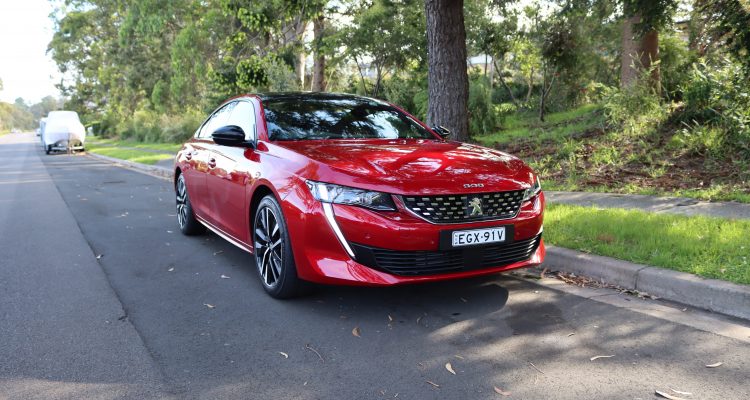
Leave a Reply